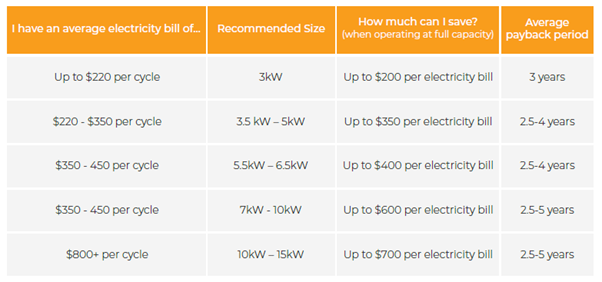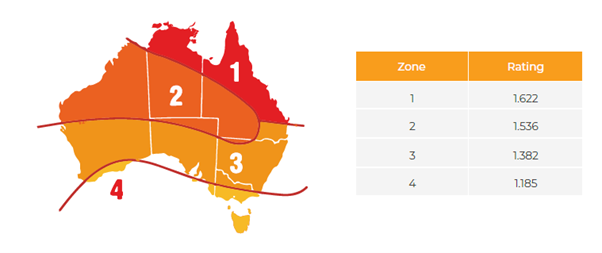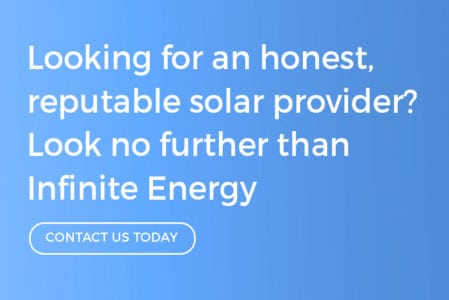Planning for solar in 2021

Beginning your solar journey
For many households in Australia, high energy bills are a common challenge year-round, but particularly in the peak of summer and winter. If you’re experiencing extremely high energy bills or would simply like to lower your electricity bills, then investing in solar is a great choice.
Once you’ve made the decision to begin looking into solar, research should be your next step. After all, solar is a significant investment and you should ensure you choose a quality system that will last for decades to come. To help make things easier for you, we have created this brief guide with some of the basics you need to consider if you are buying solar. For a more detailed breakdown, you can download our free eBook here.
What size solar system do you need?
The below table can provide you with a rough idea of what size system might work best for your energy needs. You should also consider whether your energy requirements are going to increase in the future, such as welcoming a new family member or the installation of a pool or air conditioning.

Please note, this chart has been designed as a guide only and a number of additional factors need to be considered including the size of your roof, what time of the day you use the majority of your energy and your future circumstances. Purchasing a battery, whether at the time of your installation or later, may also mean a larger system is required.
Infinite Energy can help you decide the best system size for your energy needs.
Government rebates and incentives
When you install a solar system, you generate Small-scale Technology Certificates (STCs). These certificates can be sold and are used to subsidise the upfront cost of purchasing a solar system. The amount you receive is based on how much electricity the solar system will generate until 2031 (when the initiative ends). Therefore, you will acquire more STCs for larger systems, and less for smaller systems.
The trading price for STCs can fluctuate, but on average they are traded between $35-$38 per STC. There are a few different factors that can change how many STC’s you receive overall, such as which state/area code your system is installed, the size of your system and what year it is installed.
Depending on where you live in Australia, you’ll receive a different zone rating which contributes to your total STCs.
Here is a map showing the different zones and the zone ratings:

To calculate how many STCs you’ll receive, you can use the following equation:
Solar system size (kW) x Postcode Zone Rating x years left in scheme = Number of STCs.
For example, someone living in Perth who is installing a 6.6kW solar system in 2021 can expect to receive 91 STCs. If the current trading price for an STC is $37, then they will receive $3,367 in STCs which can be used to reduce the cost of their system.
Alternatively, you can calculate how many STCs you’ll receive on the REC Registry website here.
Most solar installers will handle the STC process on your behalf and will often incorporate your STC subsidy into your up-front cost.
STC phase-out
These incentives are set to reduce by around 6-7% on January 1st every year until 2031 when they are phased out completely. This means the sooner you invest in a solar power system, the more you’ll save on the upfront cost.
Are there other government rebates available?
Depending on which state you live in, there are several other government rebates that can make installing solar, and/or a battery, much more affordable. For a more detailed breakdown of what specific solar rebates are available for your state, click here.
Shopping for Quality
We always encourage our customers to shop around for multiple quotes, as this can provide a good understanding of what you get for your money.
When shopping around for solar, knowing what to look for is imperative. Each brand of panels and inverter have a specified technological design, efficiency, durability and warranty. You should take these factors into account when comparing the panels and inverter you have been offered. In many cases, cheaper components are often compromised on each of the factors listed above. This is why we always discourage customers from purchasing a cheap solar PV system.
If you are still unsure about the products, choosing a well-known, large manufacturer can give you peace of mind knowing they have been in operation for a number of years and have successfully installed hundreds, if not thousands of their products.
It’s also important to note that you should always choose a manufacturer that has a significant presence in Australia. This is because, should you need to make a warranty claim in the future, handling this with an overseas manufacturer becomes very difficult, especially if you need to cover the costs to ship the faulty components.
Extra costs to consider
While there aren’t many extra costs you’ll need to factor in when purchasing solar, in some cases you may find you need an upgrade to your existing electricity meter.
if you have an old spinning disc meter, you will require a new bi-directional meter, which your electricity retailer will install. A bi-directional meter works by measuring energy in two directions; how much energy you consume from the grid, and how much excess energy you export back to the grid. It is the piece of equipment that allows you to receive feed-in tariffs or payments through buyback schemes such as the Distributed Energy Buyback Scheme (DEBS). If you already have a digital meter, it will simply require a reprogram so that it can measure bi-directional energy flow.
If you are purchasing an Infinite Energy solar system, we will take care of all the applications needed to arrange the replacement or upgrade on your behalf.
Choosing the right solar company
As we’ve discussed, choosing quality components is a must to ensure your system performs well into the future. Equally important, is choosing the right solar company. You may feel overwhelmed by the sheer number of solar retailers out there, however, there are a few simple things you can do that can help ensure you choose a company that will support you and provide piece of mind you’ve made the right decision.
How to background check a solar company:
- Address
To ensure you aren’t accidentally entering into a contract with a backyard operator, you should always check the address on Google to see whether it is a legitimate place, not just a ‘virtual office’. Double-check by doing a Google Street view or visit in person. If the address is simply a PO box, this could be an indication they don’t have a physical office which can be a red flag.
- Business registration
When researching a solar company, you should check how long they have been registered as a business with their ABN registration (you can check here). When it comes to purchasing a solar system, it can be a bit of a gamble buying from a company that has only been around for a few years. This is because most warranty claims occur around the five-year mark, and excessive warranty claims can put a solar company out of business. If your solar company goes out of business and you find yourself needing to make a warranty claim a few years later, this can leave you really stuck, so we encourage you to go for a company that has been around for at least 5 years.
- Commercial track record
Large commercial installations (over 100kWs in size) are often a sign of a competent solar company. This is because designing and installing a system of this size is much more complicated than a standard residential installation. A lack of large-scale commercial installations could be a sign that the solar company you’re looking into may not be very qualified.
- CEC accreditation
It is imperative that you choose a solar company that is an accredited Clean Energy Council Approved Solar Retailer. A CEC Approved Solar Retailer is recognised as a business that is committed to providing a higher standard of quality and service. Choosing a company that isn’t a CEC Approved Solar Retailer could put you at risk for issues later down the track.
- Partnerships with reputable manufacturers
Quality solar manufacturers only choose to partner with solar companies that have a good reputation, a long-standing history of success in the industry, and possess the qualities that they believe reflect their business as well. For example, Infinite Energy has partnered with several outstanding solar manufacturers, such as SunPower, SolarEdge, Fronius and Sonnen.
Moving forward
Thankfully, solar PV systems require very little maintenance. This means for the majority of the time, you can sit back and let your system work for you. However, from time to time we recommend you have your system checked by a qualified CEC solar electrician to ensure everything is working efficiently.
Your panels can self-clean when it rains, however, if your panels begin to look dirty, you can follow these steps to correctly clean them yourself. Alternatively, you can hire a qualified professional to clean them for you. Just ask your solar provider for their recommendation.
If you have chosen quality components, your system should last for about 25 years. It’s important to keep a hold of your warranty documents in case something goes wrong with your system and you need to make a warranty claim.
Once everything is complete, you are ready to enjoy all the benefits of clean, renewable solar power.
If you’d like to speak to one of our residential energy consultants about getting started on your solar journey, contact us today and we’d be delighted to help.


